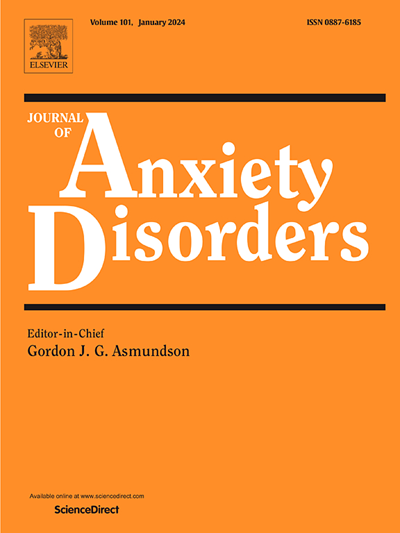Emotional growth mindsets and stress controllability buffer the link between stress intensity and anxiety symptoms: An ecological momentary assessment study
IF 4.5
2区 医学
Q1 PSYCHIATRY
引用次数: 0
Abstract
Anxiety is highly prevalent among adults. Evidence suggests that perceived stress controllability and emotional growth mindsets are associated with decreased anxiety. However, whether these positive factors synergistically contribute to reducing the impact of stress on anxiety remains unclear, especially within everyday stress contexts. Multilevel models were used to investigate how perceived stress controllability and emotional growth mindsets interacted to mitigate the adverse impact of daily stress on anxiety, differentiating within- and between-person effects. Overall, 198 participants completed ecological momentary assessments of perceived stress intensity and controllability, emotional growth mindsets, and anxiety four times daily over 10–12 consecutive days. The within-person analyses showed that high emotional growth mindsets buffer the link between perceived stress intensity and anxiety. More importantly, the between-person and cross-level results suggested that the synergistic effect of emotional growth mindsets and perceived stress controllability maximally buffered the correlation between perceived stress intensity and anxiety. Additionally, these results highlighted that the positive association between perceived stress intensity and anxiety was most pronounced among participants with low emotional growth mindsets and perceived stress controllability. These findings further support a synergistic intervention approach that emphasizes anxiety alleviation through enhanced perceived stress controllability and the development of emotional growth mindsets.
情绪成长心态和压力可控性缓冲了压力强度和焦虑症状之间的联系:一项生态瞬时评估研究
焦虑在成年人中非常普遍。有证据表明,感知压力的可控性和情绪成长心态与减少焦虑有关。然而,这些积极因素是否协同有助于减少压力对焦虑的影响仍不清楚,特别是在日常压力背景下。本研究采用多层次模型来研究感知压力可控性和情绪成长心态如何相互作用,以减轻日常压力对焦虑的不利影响,并区分人与人之间和内部的影响。总体而言,198名参与者在连续10-12天内每天完成4次感知压力强度和可控性、情绪成长心态和焦虑的生态瞬时评估。内部分析表明,高情绪成长心态缓冲了感知到的压力强度和焦虑之间的联系。更重要的是,人与人之间和跨水平的结果表明,情绪成长心态和感知压力可控性的协同效应最大程度地缓冲了感知压力强度与焦虑之间的相关性。此外,这些结果强调了感知压力强度与焦虑之间的正相关关系在情绪成长心态和感知压力可控性较低的参与者中最为明显。这些发现进一步支持了一种强调通过增强感知压力可控性和发展情绪成长心态来缓解焦虑的协同干预方法。
本文章由计算机程序翻译,如有差异,请以英文原文为准。
求助全文
约1分钟内获得全文
求助全文
来源期刊

Journal of Anxiety Disorders
Multiple-
CiteScore
16.60
自引率
2.90%
发文量
95
期刊介绍:
The Journal of Anxiety Disorders is an interdisciplinary journal that publishes research papers on all aspects of anxiety disorders for individuals of all age groups, including children, adolescents, adults, and the elderly. Manuscripts that focus on disorders previously classified as anxiety disorders such as obsessive-compulsive disorder and posttraumatic stress disorder, as well as the new category of illness anxiety disorder, are also within the scope of the journal. The research areas of focus include traditional, behavioral, cognitive, and biological assessment; diagnosis and classification; psychosocial and psychopharmacological treatment; genetics; epidemiology; and prevention. The journal welcomes theoretical and review articles that significantly contribute to current knowledge in the field. It is abstracted and indexed in various databases such as Elsevier, BIOBASE, PubMed/Medline, PsycINFO, BIOSIS Citation Index, BRS Data, Current Contents - Social & Behavioral Sciences, Pascal Francis, Scopus, and Google Scholar.
 求助内容:
求助内容: 应助结果提醒方式:
应助结果提醒方式:


